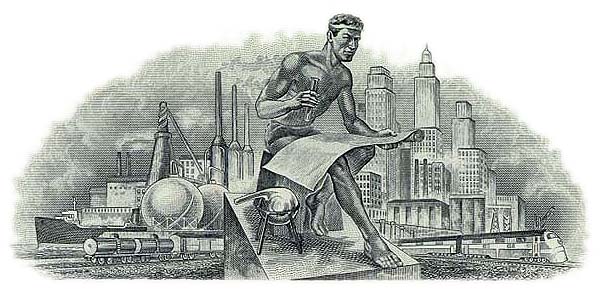| ECON 232 Chapter 12 FISCAL POLICY |
| This chapter looks briefly at the legislative mandates given to government
to pursue stabilization of the economy; it then explores the tools of government
stabilization policy in terms of the aggregate demand-aggregate (AD-AS)
model. Next, some fiscal policy measures that automatically adjust
government expenditures and tax revenues when the economy moves through
the business cycle phases are examined. Finally, problems, criticism,
and complications of government’s fiscal policy are addressed. |
I. Introduction
A. One major function of the government is to stabilize the
economy (prevent unemployment or inflation).
B. Stabilization can be achieved in part by manipulating the public
budget—government spending and tax collections—to increase output and employment
or to reduce inflation.
C. This chapter will examine a number of topics.
1. It will look at the legislative mandates given government to pursue
stabilization.
2. It explores the tools of government fiscal stabilization policy
using AD-AS model.
3. Both discretionary and automatic fiscal adjustments are examined.
4. The problems, criticisms, and complications of fiscal policy are
addressed.
|

|
II. Legislative mandates—The Employment Act of 1946
A. Congress proclaimed government’s role in promoting maximum
employment, production, and purchasing power.
B. The Act created the Council of Economic Advisers to advise the President
on economic matters.
C. It created the Joint Economic Committee of Congress to investigate
economic problems of national interest.
|
III. Fiscal Policy and the AD/AS Model
A. Discretionary fiscal policy refers to the deliberate manipulation
of taxes and government spending by Congress to alter real domestic output
and employment, control inflation, and stimulate economic growth.
“Discretionary” means the changes are at the option of the Federal government.
B. Simplifying assumptions:
1. Assume initial government purchases don’t depress or stimulate private
spending.
2. Assume fiscal policy affects only demand, not supply, side of the
economy.
C. Fiscal policy choices: Expansionary fiscal policy is used to combat
a recession (see examples illustrated in Figure 12-1).
1. Expansionary Policy needed: In Figure 12-1, a decline in investment
has decreased AD from AD1 to AD2 so real GDP has fallen and also employment
declined. Possible fiscal policy solutions follow:
a. An increase in government spending (shifts AD to right by
more than change in G due to multiplier),
b. A decrease in taxes (raises income, and consumption rises
by MPC ¥ change in income; AD shifts to right by a multiple of the
change in consumption).
c. A combination of increased spending and reduced taxes.
d. If the budget was initially balanced, expansionary fiscal policy
creates a budget deficit.
2. Contractionary fiscal policy needed: When demand?pull inflation
occurs as illustrated by a shift from AD3 to AD4 in the vertical range
of aggregate supply in Figure 12-2. Then contractionary policy is
the remedy:
a. A decrease government spending shifts AD4 back to AD3 once
the multiplier process is complete. Here price level returns to its
preinflationary level P3 but GDP remains at full-employment level.
b. An increase in taxes will reduce income and then consumption
at first by MPC ¥ fall in income, and then multiplier process leads
AD to shift leftward still further. In Figure 12-2 a tax increase
of $6.67 billion decreases consumption by 5 and multiplier causes eventual
shift to AD3.
c. A combined spending decrease and tax increase could have the
same effect with the right combination ($2 billion decline in G and $4
billion rise in T will have this effect).
D. Financing deficits or disposing of surpluses: The method used influences
fiscal policy effect.
1. Financing deficits can be done in two ways.
a. Borrowing: The government competes with private borrowers
for funds and could drive up interest rates; the government may “crowd
out” private borrowing, and this offsets the government expansion.
b. Money creation: When the Federal Reserve loans directly
to the government by buying bonds, the expansionary effect is greater since
private investors are not buying bonds. (Note: Monetarists
argue that this is monetary, not fiscal, policy that is having the expansionary
effect in such a situation.)
2. Disposing of surpluses can be handled two ways.
a. Debt reduction is good but may cause interest rates to fall
and stimulate spending. This could be inflationary.
b. Impounding or letting the surplus funds remain idle would
have greater anti?inflationary impact. The government holds surplus
tax revenues which keeps these funds from being spent.
E. Policy options: G or T?
1. Economists tend to favor higher G during recessions and higher taxes
during inflationary times if they are concerned about unmet social needs
or infrastructure.
2. Others tend to favor lower T for recessions and lower G during inflationary
periods when they think government is too large and inefficient.
|
IV. Built-In Stability
A. Built-in stability arises because net taxes (taxes minus
transfers and subsidies) change with GDP (recall that taxes reduce incomes
and therefore, spending). It is desirable for spending to rise when
the economy is slumping and vice versa when the economy is becoming inflationary.
Figure 12-3 illustrates how the built-in stability system behaves.
1. Taxes automatically rise with GDP because incomes rise and tax revenues
fall when GDP falls.
2. Transfers and subsidies rise when GDP falls; when these government
payments (welfare, unemployment, etc.) rise, net tax revenues fall along
with GDP.
B. The size of automatic stability depends on responsiveness of changes
in taxes to changes in GDP: The more progressive the tax system,
the greater the economy’s built?in stability. In Figure 12-3 line
T is steepest with a progressive tax system.
1. A 1993 law increased the highest marginal tax rate on personal income
from 31 percent to 39.6 percent and corporate income tax rate to 35% by
1 percentage. This helped prevent demand-pull inflation.
2. Automatic stability reduces instability, but does not correct economic
instability.
|
V. Evaluating Fiscal Policy
A. A full?employment budget in Year 1 is illustrated in Figure
12-4(a) because budget revenues equal expenditures when full-employment
exists at GDP1.
B. At GDP2 there is unemployment and assume no discretionary government
action, so lines G and T remain as shown.
1. Because of built?in stability, the actual budget deficit will rise
with decline of GDP; therefore, actual budget varies with GDP.
2. The government is not engaging in expansionary policy since budget
is balanced at F.E. output.
3. The full-employment budget measures what the Federal budget deficit
or surplus would be with existing taxes and government spending if the
economy is at full employment.
4. Actual budget deficit or surplus may differ greatly from full?employment
budget deficit or surplus estimates.
C. In Figure 12-4b, the government reduced tax rates from T1 to T2,
now there is a F.E. deficit.
1. Structural deficits occur when there is a deficit in the full?employment
budget as well as the actual budget.
2. This is expansionary policy because true expansionary policy occurs
when the full?employment budget has a deficit.
D. If the F.E. deficit of zero was followed by a F.E. budget surplus,
fiscal policy is contractionary.
E. Recent U.S. fiscal policy is summarized in Table 12-1.
1. Observe that F.E. deficits are less than actual deficits.
2. Column 3 indicates expansionary fiscal policy of early 1990s became
contractionary in the later years shown.
3. Actual deficits have disappeared and the U.S. budget has actual
surpluses since 1999. (Key Question 7)
F. Global Perspectives 12-1 gives a fiscal policy snapshot for selected
countries.
|
VI. Problems, Criticisms and Complications
A. Problems of timing
1. Recognition lag is the elapsed time between the beginning of recession
or inflation and awareness of this occurrence.
2. Administrative lag is the difficulty in changing policy once the
problem has been recognized.
3. Operational lag is the time elapsed between change in policy and
its impact on the economy.
B. Political considerations: Government has other goals besides
economic stability, and these may conflict with stabilization policy.
1. A political business cycle may destabilize the economy: Election
years have been characterized by more expansionary policies regardless
of economic conditions.
a. political business cycle?
2. State and local finance policies may offset federal stabilization
policies. They are often procyclical, because balanced-budget requirements
cause states and local governments to raise taxes in a recession or cut
spending making the recession possibly worse. In an inflationary
period, they may increase spending or cut taxes as their budgets head for
surplus.
3. The crowding?out effect may be caused by fiscal policy.
a. “Crowding?out” may occur with government deficit spending.
It may increase the interest rate and reduce private spending which weakens
or cancels the stimulus of fiscal policy. (See Figure 12-5)
b. Some economists argue that little crowding out will occur
during a recession.
c. Economists agree that government deficits should not occur
at F.E., it is also argued that monetary authorities could counteract the
crowding?out by increasing the money supply to accommodate the expansionary
fiscal policy.
C. With an upward sloping AS curve, some portion of the potential impact
of an expansionary fiscal policy on real output may be dissipated in the
form of inflation. (See Figure 12-5c)
|
VII. Fiscal Policy in an Open Economy (See Table 12-2)
A. Shocks or changes from abroad will cause changes in net
exports which can shift aggregate demand leftward or rightward.
B. The net export effect reduces effectiveness of fiscal policy:
For example, expansionary fiscal policy may affect interest rates, which
can cause the dollar to appreciate and exports to decline (or rise).
|

|
VIII. Supply-Side Fiscal Policy
A. Fiscal policy may affect aggregate supply as well as demand
(see Figure 12-6 example).
B. Assume that AS is upward sloping for simplicity.
C. Tax changes may shift aggregate supply. An increase in business
taxes raises costs and shifts supply to left; decrease shifts supply
to the right.
1. Also, lower taxes could increase saving and investment.
2. Lower personal taxes may increase effort, productivity and, therefore,
shift supply to the right.
3. Lower personal taxes may also increase risk?taking and, therefore,
shift supply to the right.
D. If lower taxes raise GDP, tax revenues may actually rise.
E. Many economists are skeptical of supply-side theories.
1. Effect of lower taxes on a supply is not supported by evidence.
2. Tax impact on supply takes extended time, but demand impact is more
immediate.
|

|
IX. LAST WORD: The Leading Indicators
A. This index comprises 10 variables that have indicated forthcoming
changes in real GDP in the past. Similar indicies are published by the
American Institute for Economic Reseach in Great Barrington, Massachusetts,
and the Conference Board in New York, New York.
B. The variables are the foundation of this index consisting of a weighted
average of ten economic measurements. A rise in the index predicts
a rise in the GDP; a fall predicts declining GDP.
C. Ten components comprise the index:
1. Average workweek: A decrease signals future GDP decline.
2. Initial claims for unemployment insurance: An increase signals
future GDP decline.
3. New orders for consumer goods: A decrease signals GDP decline.
4. Vendor performance: Better performance by suppliers in meeting
business demand indicates decline in GDP.
5. New orders for capital goods: A decrease signals GDP decline.
6. Building permits for houses: A decrease signals GDP decline.
7. Stock market prices: Declines signal GDP decline.
8. Money supply: A decrease is associated with falling GDP.
9. Interest-rate spread: when short-term rates rise, there is a smaller
spread between short-term and long-term rates which are usually higher.
This indicates restrictive monetary policy.
10. Index of consumer expectations: Declines in consumer confidence
foreshadow declining GDP.
D. None of these factors alone is sufficient to predict changes in GDP,
but the composite index has correctly predicted business fluctuations many
times (although not perfectly). The index is a useful signal, but
not totally reliable.
|




